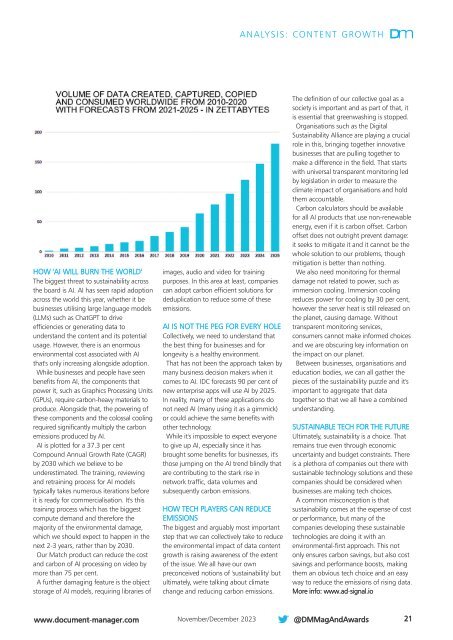You also want an ePaper? Increase the reach of your titles
YUMPU automatically turns print PDFs into web optimized ePapers that Google loves.
ANALYSIS: CONTENT GROWTH Dm<br />
HOW 'AI WILL BURN THE WORLD'<br />
The biggest threat to sustainability across<br />
the board is AI. AI has seen rapid adoption<br />
across the world this year, whether it be<br />
businesses utilising large language models<br />
(LLMs) such as ChatGPT to drive<br />
efficiencies or generating data to<br />
understand the content and its potential<br />
usage. However, there is an enormous<br />
environmental cost associated with AI<br />
that's only increasing alongside adoption.<br />
While businesses and people have seen<br />
benefits from AI, the components that<br />
power it, such as Graphics Processing Units<br />
(GPUs), require carbon-heavy materials to<br />
produce. Alongside that, the powering of<br />
these components and the colossal cooling<br />
required significantly multiply the carbon<br />
emissions produced by AI.<br />
AI is plotted for a 37.3 per cent<br />
Compound Annual Growth Rate (CAGR)<br />
by 2030 which we believe to be<br />
underestimated. The training, reviewing<br />
and retraining process for AI models<br />
typically takes numerous iterations before<br />
it is ready for commercialisation. It's this<br />
training process which has the biggest<br />
compute demand and therefore the<br />
majority of the environmental damage,<br />
which we should expect to happen in the<br />
next 2-3 years, rather than by 2030.<br />
Our Match product can reduce the cost<br />
and carbon of AI processing on video by<br />
more than 75 per cent.<br />
A further damaging feature is the object<br />
storage of AI models, requiring libraries of<br />
images, audio and video for training<br />
purposes. In this area at least, companies<br />
can adopt carbon efficient solutions for<br />
deduplication to reduce some of these<br />
emissions.<br />
AI IS NOT THE PEG FOR EVERY HOLE<br />
Collectively, we need to understand that<br />
the best thing for businesses and for<br />
longevity is a healthy environment.<br />
That has not been the approach taken by<br />
many business decision makers when it<br />
comes to AI. IDC forecasts 90 per cent of<br />
new enterprise apps will use AI by 2025.<br />
In reality, many of these applications do<br />
not need AI (many using it as a gimmick)<br />
or could achieve the same benefits with<br />
other technology.<br />
While it's impossible to expect everyone<br />
to give up AI, especially since it has<br />
brought some benefits for businesses, it's<br />
those jumping on the AI trend blindly that<br />
are contributing to the stark rise in<br />
network traffic, data volumes and<br />
subsequently carbon emissions.<br />
HOW TECH PLAYERS CAN REDUCE<br />
EMISSIONS<br />
The biggest and arguably most important<br />
step that we can collectively take to reduce<br />
the environmental impact of data content<br />
growth is raising awareness of the extent<br />
of the issue. We all have our own<br />
preconceived notions of 'sustainability' but<br />
ultimately, we're talking about climate<br />
change and reducing carbon emissions.<br />
The definition of our collective goal as a<br />
society is important and as part of that, it<br />
is essential that greenwashing is stopped.<br />
Organisations such as the Digital<br />
Sustainability Alliance are playing a crucial<br />
role in this, bringing together innovative<br />
businesses that are pulling together to<br />
make a difference in the field. That starts<br />
with universal transparent monitoring led<br />
by legislation in order to measure the<br />
climate impact of organisations and hold<br />
them accountable.<br />
Carbon calculators should be available<br />
for all AI products that use non-renewable<br />
energy, even if it is carbon offset. Carbon<br />
offset does not outright prevent damage:<br />
it seeks to mitigate it and it cannot be the<br />
whole solution to our problems, though<br />
mitigation is better than nothing.<br />
We also need monitoring for thermal<br />
damage not related to power, such as<br />
immersion cooling. Immersion cooling<br />
reduces power for cooling by 30 per cent,<br />
however the server heat is still released on<br />
the planet, causing damage. Without<br />
transparent monitoring services,<br />
consumers cannot make informed choices<br />
and we are obscuring key information on<br />
the impact on our planet.<br />
Between businesses, organisations and<br />
education bodies, we can all gather the<br />
pieces of the sustainability puzzle and it's<br />
important to aggregate that data<br />
together so that we all have a combined<br />
understanding.<br />
SUSTAINABLE TECH FOR THE FUTURE<br />
Ultimately, sustainability is a choice. That<br />
remains true even through economic<br />
uncertainty and budget constraints. There<br />
is a plethora of companies out there with<br />
sustainable technology solutions and these<br />
companies should be considered when<br />
businesses are making tech choices.<br />
A common misconception is that<br />
sustainability comes at the expense of cost<br />
or performance, but many of the<br />
companies developing these sustainable<br />
technologies are doing it with an<br />
environmental-first approach. This not<br />
only ensures carbon savings, but also cost<br />
savings and performance boosts, making<br />
them an obvious tech choice and an easy<br />
way to reduce the emissions of rising data.<br />
More info: www.ad-signal.io<br />
www.document-manager.com<br />
<strong>Nov</strong>ember/<strong>Dec</strong>ember <strong>2023</strong><br />
@<strong>DM</strong>MagAndAwards<br />
21
















